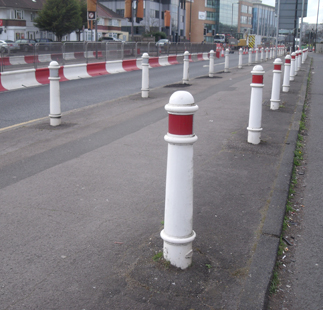The Westminster terror attack of March 22 raises security and safety questions about a place city-goers take for granted more than any other; the pavement, writes Mark Rowe.
Any gathering or concentration of people – such as a queue – may feel vulnerable to being rammed, after the attacks with a lorry in Nice and Berlin, and in London. That can be tourists and others waiting for one of the South Kensington museums to open; crowds hanging around outside a stadium before a match; and queues of night-club goers waiting to be let in by door staff. As someone in that field told Professional Security, the sort of people who go to clubs are the sort that extremists hate – as proven by the shooting at the Bataclan club in Paris in November 2015.
When Professional Security put some of this to a UK safety sector figure, they spoke in terms of compromise; even if bollards are added to pavements on bridges to deter and prevent a vehicle from mounting the pavement, a motorcycle could still be a weapon. And indeed any pavement walker accepts the risk that an elderly driver might mount the pavement by accident. People routinely walk on pavements listening to music on headphones oblivious to their surroundings. You cannot make people do what they don’t want to; securing pavements is difficult and there is not any obvious answer (pictured is the A4 just to the west of Slough town centre; should every town and city have such street furniture on every stretch of road?). Such security measures might only push the threat further out to where the measures aren’t, just as the extensive physical security measures around the Houses of Parliament and (not as overt) along Whitehall may have pushed the Westminster attacker to the bridge.
As London visitors and workers regardless went about their business, including queueing and congregating, we can query how reassuring the Met Police patrols were. If a Westminster-style attack were to target the queue for the South Kensington museums, for instance, it is hard to see what unarmed uniformed police could do to stop the vehicle, any more than anyone else.
The threat to queues extends to business exhibitions, including ironically the Security Expo 2016 which had a snake of visitors around the block, ironically having to wait half an hour or more for entry to the London Olympia show because of the bottleneck of security checks for issuing passes and x-ray machine searches of bags at the door.
Specialist barriers were put in place around Windsor Castle ahead of the Guard Change on Wednesday, March 29, one week after the use of a car as a weapon on Westminster Bridge. Assistant Chief Constable Dave Hardcastle, head of operations for Thames Valley Police, said: “While there is no intelligence to indicate a specific threat to Windsor, recent events in Westminster clearly highlight the need for extra security measures to be introduced. The force believes that it is proportionate and necessary to put in place extra security measures to further protect and support the public and the Guard Change. This is consistent with security deployments in London.”










